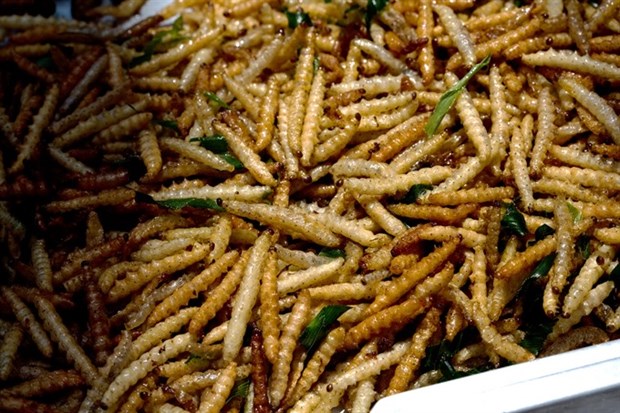Only
elders in these two ethnic minority communities residing mostly in the northern
and central provinces know how to collect the worm and make tasty dishes with
it.
A
few weeks ago, in a homestay arrangement in Hoàng Su Phì District, Hà Giang
Province, we enjoyed the luck of being served a special Dao Đỏ meal.
When
the meal was served, besides the traditional dishes like steamed cassava pie
and fried mountain snail, there was a plate of stir-fried sâu tre and a bowl of
sâu tre soup.

Tough love: Stir-fried bamboo worms is a favourite dish for many people. Creepy at first sight, it soon becomes an addiction. — Photo daikynguyenvn.com
Once
it is cooked, sâu tre takes on a golden colour. The worm looked like a
chrysalis, somewhat smaller. Despite the eye-catching decoration and colour, we
were still afraid of tasting the dish.
Triệu
Mùi Mủi, our 43-year-old host, laughed and said: “Try it out, then you will
find it delicious. Many people have hesitated like you, but all of them then
became addicted to the dish. It is really a nice one.”
With
such encouragement, we had to go for it.
And
she was right. We fell for it immediately. It was succulent, juicy, and the
herbs used had blended well with it.
Mủi
told us that there are different ways to cook sâu tre. It could be deep fried,
steamed or braised, but the most popular dish was sâu tre stir fry.
The
worms are washed and cleaned carefully, seasoned with salt and set aside for 15
minutes. Fat (lard or oil) is heated in a pan, and shallots as well as the
worms are added to it. After stir-frying for about three minutes, when the
worms taken on a light golden colour, finely chopped lime leaves are added. A
quick stir-fry, and the dish is served immediately.
The
mild scent of the bamboo, the strong flavour of sâu tre and the light
bitterness of lime leaves make for a special, tasty dish perfect to enjoy on
cold and humid days.
Mủi
told us that sâu tre was a special dish for mountainous communities. People
began collecting them when they lived mostly of the land, and food became
scarce.
As
other food became more easily available in the market, the sâu tre was no
longer a must. Young people soon forgot how to collect and cook it. Also, sâu
tre requires a lot of ingridients, additives, and several steps are involved,
from collecting it to preparing it and cooking it. It can even take more than a
day to serve a sâu tre dish, Mủi said.
“So
today we just cook sâu tre to serve guests. It is difficult to collect, so even
when someone is willing to order and pay in advance, we have to say no.”
Finding sâu tre
According
to Mủi, the bamboo worm season normally lasts from September till the end of
October, during which the worms are the fattest and give birth the most. She
said it used to be easy for people in the past. They could tell with just a
glance which was the right bamboo to find the worms in.
“But
for young people now, it depends on their luck.” she said.
To
collect sâu tre, a knife and a basket are the tools required. People look for
dry and almost dead bamboo grass, chop them down then empty the stalks to get
the worms inside. On a lucky day, one can get 1 to 1.5 kg of sâu tre. The worm
is white and 3.5 to 4cm long.
In
Việt Nam, this special worm can be found in the northern mountainous provinces
of Điện Biên, Lai Châu, Sơn La and Hà Giang or central provinces like Thanh Hóa
and Thừa Thiên-Huế.
Even
during the breeding season, it is not easy to get them, because not every
bamboo section will carry them.
“However,
the rarer the insect is, the higher its price on the market,” Mủi said.
During
its season, prices for this mountain specialty can go be up to half a million đồng
(US$23) per kilo, but supply still fails to met rising demand. People have to
order about a week in advance to be served this dish.
Another
factor that raises the price of bamboo worm is difficulties in transportating
them.
“Delivering
the bamboo worm alive is hard to do. And if they are not careful enough, the
worms will die so the dishes will not be as tasty as expected,” said Lê Văn Thọ,
a sâu tre wholesaler. “Therefore, as soon as I gather enough of them, I do not
wait. I get them straight to the customer, so they are fresh and my loss is
reduced.”
But
for those who have taken to them, all the trouble taken, and the price, are
worth it.
“I
have to order bamboo worms in Thanh Hóa Province one week earlier,” said Nguyễn
Hoàng Quân, who lives on Hoàng Hoa Thám Street in Hà Nội. And he sometimes
waits for two hours at the bus terminal to collect the delivery.
“My
very first time, I felt creepy on seeing the worms on the table, but I fell in
love with their crispy, aromatic and greasy taste after my first attempt.
“After
just one bite, and I wanted to have more and more, and have, unconsciously,
become addicted to them.”

Finder’s keepers: Bamboo worms can be found in dry and almost dead bamboo trees. — Photo vietnamshopping.net

Dear, dear: During the season, the price for this mountainous specialty, the bamboo worm, can go up to half a million đồng (US$23) per kilo, but the supply still cannot meet rising demand. — Photo viedaikynguyen.com
By Lương Thu Hương/Vietnamnews